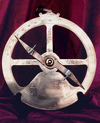DWR Champagne Chairs
I really like these little chairs made out of Champagne parts. The winner is a neat little chair made from the cork and wire- runners up include “corky” a dual cork chair, “folding cotillion” a fold up chair version and my favorite- “The DaVidRo Chair” a melted bottle with a cork based that looks really comfy. Link.





 Interesting article about how much electricity we use. That big screen TV might just be the SUV of power consumption in your house. With all the sales of big screen TVs we might need to develop more energy saving technolgies. The average US household used 10,656 kilowatt-hours of electricity in 2001- what used the most? [
Interesting article about how much electricity we use. That big screen TV might just be the SUV of power consumption in your house. With all the sales of big screen TVs we might need to develop more energy saving technolgies. The average US household used 10,656 kilowatt-hours of electricity in 2001- what used the most? [
 DVD ripping and transcoding with Linux. This is a very specific tutorial about the DVD rippping and transcoding, using Mplayer and Transcode. It is well organized and it contains specific information about the codecs, the aspect ratio, the audio and other specifics. Recommended. Mplayer HOWTO. The original Mplayer HOWTO. They are a huge and precious source of information of any kind about the video playing/encoding. Plus, the supported OS are Linux, Windows, MacOSX, FreeBDS… you got it. A must for any serious user, everybody should take a careful look at it.
DVD ripping and transcoding with Linux. This is a very specific tutorial about the DVD rippping and transcoding, using Mplayer and Transcode. It is well organized and it contains specific information about the codecs, the aspect ratio, the audio and other specifics. Recommended. Mplayer HOWTO. The original Mplayer HOWTO. They are a huge and precious source of information of any kind about the video playing/encoding. Plus, the supported OS are Linux, Windows, MacOSX, FreeBDS… you got it. A must for any serious user, everybody should take a careful look at it. 
 Dale Dougherty and Phillip Torrone from MAKE Magazine will be on the airwaves 8am PST 90.9 WBUR Boston, MA- NPR. The Makers of MAKE: A new quarterly magazine wants America to go back to the garage and get in touch with its inner geek. It’s a throwback to the how-to journals of the ’50s like Popular Mechanics…but using 21st century technology. Call in, ask questions and say hi!
Dale Dougherty and Phillip Torrone from MAKE Magazine will be on the airwaves 8am PST 90.9 WBUR Boston, MA- NPR. The Makers of MAKE: A new quarterly magazine wants America to go back to the garage and get in touch with its inner geek. It’s a throwback to the how-to journals of the ’50s like Popular Mechanics…but using 21st century technology. Call in, ask questions and say hi! 
 SmartAz writes- This no-frames, no frills website is dedicated to those brave experimenters spending time in building their own backpacking stoves or modifying commercial made ones. New designs are added from time to time. Currently the site has 28 designs with costs ranging from zero to ten bucks, depending on whether you buy materials or find them.
SmartAz writes- This no-frames, no frills website is dedicated to those brave experimenters spending time in building their own backpacking stoves or modifying commercial made ones. New designs are added from time to time. Currently the site has 28 designs with costs ranging from zero to ten bucks, depending on whether you buy materials or find them. 
 Astrolabes are probably the the sini qua non of ancient instruments. They have been collected for centuries, and forgeries have been made for centuries, though genuine, working, astrolabes were made in Islamic countries up through the nineteenth century. For background information on astrolabes a number of books are available…The Astrolabe site on the Internet provides a brief essay on the astrolabe, museums having astrolabe collections, a history of the astrolabe, and finally, astrolabe links, references, and reproductions, including a “personal astrolabe” available for a fee made by that site’s creator. Thanks
Astrolabes are probably the the sini qua non of ancient instruments. They have been collected for centuries, and forgeries have been made for centuries, though genuine, working, astrolabes were made in Islamic countries up through the nineteenth century. For background information on astrolabes a number of books are available…The Astrolabe site on the Internet provides a brief essay on the astrolabe, museums having astrolabe collections, a history of the astrolabe, and finally, astrolabe links, references, and reproductions, including a “personal astrolabe” available for a fee made by that site’s creator. Thanks 
 Some really interesting projects for UAVs you can build yourself! Robotics and autonomous agents are way more interesting to me than writing the same organization process-oriented software every day. I’ve been doing a lot of research on autonomous micro-air vehicles (MAV) and Unmaned aerial vehicles (UAV) lately and I’ve come across a few Open Source projects…
Some really interesting projects for UAVs you can build yourself! Robotics and autonomous agents are way more interesting to me than writing the same organization process-oriented software every day. I’ve been doing a lot of research on autonomous micro-air vehicles (MAV) and Unmaned aerial vehicles (UAV) lately and I’ve come across a few Open Source projects…